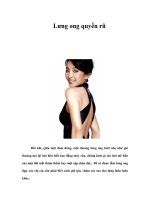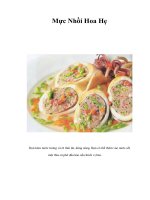Tài liệu Quick Zip Makeup Bag pptx
Bạn đang xem bản rút gọn của tài liệu. Xem và tải ngay bản đầy đủ của tài liệu tại đây (635.12 KB, 10 trang )
Fun with Fabric 1
Quick Zip Makeup
Bag
12 Hours
What will you learn?
How to:
Select coordinating printed fabrics
Prewash fabrics before using them
Strip quilt (stitch and flip quilting)
Put in an exposed zipper
What will you need?
A sewing machine and basic sewing tools
Quilting weight cotton fabric: 2 fabrics that look nice together, ¼ yd. of each will make
several bags, you can also use fat quarter cuts of fabric (fat quarters are 18” by about
22”)
11”x14” piece of fusible fleece, Pellon™ Fleece, or cotton batting (these products will
take the heat of an iron, most polyester batting will not)
11”x14” piece of cotton muslin fabric (this will be the lining, you may use cotton quilting
fabric if you wish)
14 inch polyester dress zipper to go with your fabric
6 inches of 1/4” ribbon to go with your fabric
Thread to go with your fabric
Seam Allowances: ¼ inch or use the right edge of your presser foot as a seam guide
(a standard presser foot on most sewing machines makes a 3/8 inch seam allowance)
Directions to make this project:
1. Prewash all your fabrics in warm water on a gentle cycle with laundry detergent,
rinse with cold water, and dry on warm until dry. High heat and overdrying your fabrics
will cause wrinkles to form that will be difficult to remove.
Fun with Fabric 2
2. Carefully press your fabric flat. Use steam if necessary. With right sides of fabric
together, line up the selvages of your fabric and smooth toward the fold. If there are
wrinkles, keep the selvage edges together but shift your fabric sideways until there are
no wrinkles. If you are using fat quarter cuts of fabric, just fold the fabric in half so you
have a rectangle 9” by about 22”.
3. Square up one end of your fabric so you can cut straight strips. From your favorite
print; cut 3 strips 2 ¼ inches wide by 14 inches long. From the other fabric; cut 4 strips,
1 3/4” wide by 14 inches long. (If your machine has a ¼” presser foot, you may cut
your strips 2” and 1 ½” wide to make them look like the makeup bags in the picture.)
4. Fusebaste the lining fabric to the piece of fusible fleece following the
manufacturer’s instructions. Make sure you fuse to the side of the fleece that has glue
on it. If you are using Pellon™ Fleece or cotton batting, use scraps of fusible web to
baste your fabric to your fleece or cotton batting. Sometimes the polyester fleece or
cotton batting has a type of glue on the surface that will hold the backing fabric without
using the fusible web. You may also fusebaste with a spray basting glue like Quilt
Baste. If you have a printed fabric for lining, fusebaste the wrong side of the fabric to
the fleece or cotton batting.
5. Place one of the wider strips right side up on the center of short side of the fleece
side of your fleece and lining fabric unit. Use a couple of pins on the left side of the
strip to keep it straight and hold it in place while you position the next strip of fabric.
Take a narrower strip and place it wrong side up with one cut edge aligned with the
right edge of the wider strip. Stitch down the aligned edges, using the edge of your
presser foot as a guide.
Center first strip. Position next strip on top. Stitch strips.
6. Flip the narrower strip to the side so you can see the right side of both fabrics and
press it carefully to the side. Now take a wider strip and place it right side down so it is
aligned with the cut edge of the last strip you stitched down, flipped, and pressed.
Repeat the stitching, flipping, and pressing with a wide strip. Then, repeat again with a
narrower strip.
Fun with Fabric 3
Flip and press. Add next strip and stitch.
Flip and press again. Add last strip.
7. Rotate the fleece/backing fabric so you can repeat the flipping and stitching
process with your remaining strips. You should have three wide strips and four narrow
strips stitched down on your fleece and lining fabric unit.
8. Trim the strips even with the fleece and backing then trim the fleece and backing
even with the last strip of fabric on each long side. Next, square up each short side so
you have a rectangle about 9 ½” x 12 ½”. It is important that the short ends are the
same width and that the long sides are trimmed to equal lengths.
Fun with Fabric 4
9. Shape each short end with the curved pattern piece provided. Use the center fold
line to match to the center of each short side.
10. Serge or zigzag around all edges. The zigzag stitching should be right on the edge
to hold the layers together and prevent raveling. Use a zigzag stitch with a stitch width
of 3.5 and a length of 3.0.
11. Apply the zipper to the curved ends of your strippieced rectangle using the
exposed method. Center the zipper face down along the curve, aligning the edge of
the curve with the edge of the zipper tape. Pin. Find where the zipper tape will start
and end on the curve. Mark both sides of the zipper teeth as a reference at both the
starting and ending point.
Fun with Fabric 5
Pin and mark where the zipper tape matches the curve at the beginning and end.
12. Put a zipper foot on your sewing machine and stitch with the needle making a
seam line a scant 1/4” from the zipper teeth or the edge of the zipper tape, whatever is
easiest to do with the type of zipper foot you have for your machine. If it is easier to
follow the zipper teeth, you may want to open the zipper for this step. If you don’t have
a zipper foot, you can do this step with the multipurpose foot or an open toe foot
appliqué/decorative stitching foot. Backstitch at the beginning and end of this seam.
13. Close the zipper. Center and pin the other side of the zipper tape to the other
curved edge of your stripped pieced rectangle using the marks you made in step 11. It
is important to have the zipper tape start and end at the same points on both sides.
Repeat step 12 for the second side of the zipper.
14. Zigzag the edge of the zipper tape to the curved edge of the stripped pieced
rectangle on each side of the zipper. This will keep the zipper from catching the zipper
tape or quilted fabric.









